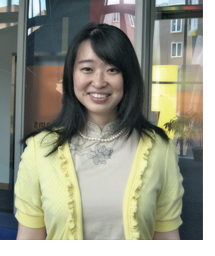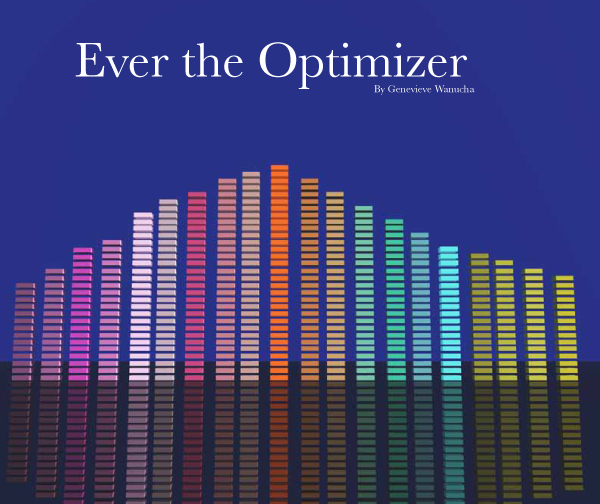Ermin Wei is one of the newest members of LIDS, yet she's already had a taste of how her ideas in distributed optimization could change technology. Last year at the IEEE Conference on Decision and Control in Atlanta, she presented her MIT Master's thesis on a fast-distributed algorithm, basically a scheme that could make the Internet run much faster. A bunch of Internet engineers approached her after the talk, exclaiming, "This could change our TCP protocol!" Their enthusiasm took Ermin by surprise. "Working on a theory makes me feel a little far from reality from time to time. I didn't know if people would actually use it, so it was a big shock." Now a first year PhD student, she is still hard at work on the new algorithm's mathematics.
Ermin works on network utility maximization. With pencil, paper and simulations, she figures out how to best allocate resources through a network. These calculations are relevant for any kind of network, whether it's Internet wires, highway and road systems, or electrical grids. A simple example is railroads. You can only send so many trains through tracks at once. The trains will travel on predetermined paths, but each may have a different priority. To achieve maximum utility, engineers need to know how to send the most trains through the system without overloading it and causing delays.
But scaling up to a network as complex as the Internet, this optimization problem grows daunting. Our on-line world is a large-scale network of networks that must handle huge amounts of random data flooding interconnected wires. Certain computers have security constraints, so there can be no central planner monitoring everything and directing data flow. Instead, computers only know some information about their neighbors and only use local information to talk to each other. Currently, the Internet uses a slow distributed algorithm dating back to 1997. Ermin and researchers like her want to create an algorithm for a faster Web of the future.
As an undergraduate at University of Maryland at College Park, she started out in computer engineering. An insatiable desire for challenging material and a desire to learn more drove her to add another major in finance and later a third in mathematics. Searching for an exciting project for the summer after freshman year, she joined the Intelligent Servosystems Laboratory in the Institute for Systems Research. There, with the unlikely partner of the big brown bat, Ermin discovered her love of applied math under the supervision of Professor P. S. Krishnaprasad from the Department of Electrical and Computer Engineering.
At the time, Krishnaprasad and his students were studying the dynamics of bat echolocation, the biologically genius sense system that allows bats to navigate and hunt using sound waves. Bats are nocturnal, so the lab members had to give them "jet lag training," turning off the lights in the day and exposing them to light at night. After the bats adjusted to a human schedule, Ermin set up nets in different shapes, and videotaped the flight paths of the bats as they zoomed towards an insect buzzing at the far end of the nets. She analyzed how bats skillfully, yet blindly, pilot themselves around the curvatures standing in the way.
Ermin joined one project to apply evolutionary game theory to the analysis of pursuit laws found in the brown bat's sonar hunting. Did bats use classical strategy, and simply follow their prey? Or, did the nocturnal creatures use motion camouflage; a method of capturing prey in the shortest possible time, given the prey has a piecewise linear path, which would give them an evolutionary edge. Surprisingly, they found that bats do use motion camouflage in experiments. "We didn't expect that nature would use a sophisticated time-optimal approach," she remembers. It was a transitional moment for Ermin, a recognition that math is beautiful. When applied to real world problems, the result is beyond an equation, it presents an intuitive approach to the world. "That got me into research," she says.
Here at LIDS, Ermin works with her advisor Professor Asu Ozdaglar from the Department of Electrical Engineering and Computer Science. Asu's unconditional supportiveness has become especially important. Applied mathematics, though excitingly intuitive, comes with its special challenges. "There is a common saying at LIDS," Ermin says. "90% of the time, you are stuck on a proof, 1% of the time you make a breakthrough, and the other 9% of the time you are writing a paper. A student can get stressed out and disappointed!" But sometimes when Ermin feels about to give up, talking with Asu gives her an immediate energy boost and a flow of new ideas.
"You feel the energy radiating out of her," Ermin says of Asu, who has interests in game theory, social networking, and of course, distributed optimization. She cares a lot about her students, helping them with idea generation and technical writing, and advocating for them at conferences. Working with Asu has inspired Ermin to think of her own future as a professor and advisor. She has realized that an academic setting gives freedom for meaningful research. And most importantly, "a good advisor can have a huge impact on students," she says.
The social, interactive atmosphere of LIDS also tempers the academic frustrations. Reflective of LIDS's multidisciplinary nature, researchers have diverse interests and personal backgrounds. A short while ago, Ermin asked everyone to sign a birthday card for Asu, using his or her first language. "We ended up with 8 different languages," she remembers. "But no English!"
Ermin's desire to make an impact on real world problems has her thinking of future research directions. She's particularly attracted to the mathematical foundations of efficient energy systems, or smart grids. If we price energy according to demand, laundry machines, dishwashers, and air conditioners could work more when other appliances aren't using it. Electricity could be locally stored. We could use it when the price is high, and could sell any extra on the open market. However, smarter energy use is a classic distributed optimization problem. Someone needs to figure out how to implement such a system on the enormous scale of entire cities. There is no question that Ermin will be an optimal person for the task.




